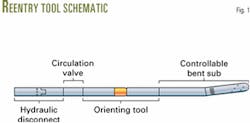Coiled tubing provides the means to work in live wells, allowing wellbore clean-outs, openhole-formation washes, selective-matrix stimulation, production logs, and nitrogen-kickoff jobs.
Until recently, however, reliable coiled-tubing reentry techniques were not available for selective access of multilateral legs in TAML (Technical Advancement of Multilateral wells) Level 1 and 2 lateral extensions.
With introduction of a new multilateral reentry technique and tool, selective and efficient access to multilateral legs has become available for many common coiled-tubing operations, without forcing operators to install TAML Level 3 to 6 reentry-enabling completion designs.
This is according to a presentation earlier this year to the International Association of Drilling Contractors and Society of Petroleum Engineers drilling conference in Dallas.
Reentry tool, system
Representing several Schlumberger Ltd. authors of the paper, Henry Wortmann said that, at a well's multilateral junction, the end of the coiled tubing encounters a natural leg and a "non-natural" leg.
The coiled tubing would readily pass into the natural leg with a straight bottomhole assembly (BHA). But gaining entry into a nonnatural leg requires that the end of the coiled tubing be directed or forced.
Once the end of the coiled-tubing passes the multilateral junction, verifying into which lateral the coiled-tubing actually has entered is most reliably done by running to the end of the lateral and tagging total depth.
If the lateral length is several thousand feet, however, verifying total depth as a means of identifying the lateral leg requires time, especially with trial-and-error lateral access methods.
The coiled-tubing reentry system identifies the window of the selected lateral, before attempting reentry, with use of a reentry bottomhole assembly (BHA).
Schlumberger's Discovery MLT tool consists of a surface-controlled orienting tool and a controllable bent sub (Fig. 1). Initially, the company designed the tool with 31/16-in. OD but has since designed a 21/8-in. OD version of the tool for smaller wellbores.
Operating solely on flow and conveyed with standard coiled-tubing equipment, the tool profiles the lateral junction during upward passes instead of rotating a full cycle at a specified depth (Fig. 2).
With the orienting tool, the coiled-tubing unit operator changes the bent-sub orientation relative to the lateral window, indexing 12 times to cover 360°.
Even if the tool is not immediately oriented because the bent sub is locked in a washout, upward movement of the wand allows the tool to flip in the desired orientation after the first few inches of movement.
At surface, a software-displayed pressure log confirms successful identification and entry through the window (Fig. 3).
Case history, 90° lateral
In September 2001, the coiled-tubing reentry tool was first used in Canada to acidize, in one run with coiled-tubing, both sidetracks of an Alberta well that had two 61/2-in. openhole horizontal laterals drilled 90° from each other.
The operator had drilled the south natural-leg lateral to 14,649 ft MD and the east lateral to 13,206 ft MD, with the junction at 12,041 ft MD. The rig had run 3.5-in. production tubing (2.635-in. minimum ID) to 11,581 ft.
Following the BHA surface test, the coiled-tubing reentry tool was run into the natural leg, past the lateral junction, tagging TD to confirm that the BHA had entered the south lateral.
The coiled-tubing operator pulled the tool string back to the lateral window and performed the profiling procedure while pumping at 1.5 bbl/min, generating the 12 pass, 360° window image.
After the window profile was completed, the reentry BHA was oriented to the east lateral exit and run to that lateral's TD, confirming success of the entry from the measured depth.
After dropping a 0.625-in. ball to isolate the coiled-tubing reentry BHA and opening the circulating sub, coiled-tubing crews acidized the east lateral and pulled the coiled tubing back up through the lateral junction and into the liner shoe at 11,000 ft.
While maintaining minimum pump rate and with the BHA isolated, the coiled-tubing unit's operator ran in to confirm entry into the natural-south lateral tagging TD at 14,649 ft.
Upon confirming that they had positioned the coiled tubing at the bottom of the south lateral, crews acidized the lateral according to the job design while pulling the coiled tubing out of hole.
A high-pressure jetting sub, a modified version of the original circulation sub, proved successful in cleaning drilling mud residues from the openhole laterals, with the well's production increasing from 5 to more than 29 MMcfd after stimulation.
Parallel lateral case
Driven by expected time savings over reentry attempts using other techniques on comparable wells that typically took five to seven coiled-tubing runs per well, a second Canadian operator applied the selective re-entry technique for stimulating a newly drilled dual-lateral well.
The operator drilled the 61/2-in. parallel, horizontal-lateral sections and completed them as open hole with the first leg at 11,739 ft MD and the second-natural leg at 12,123 ft MD. The lateral junction was at 7,851 ft.
The rig had run 2.875-in. production tubing in the top section of the well (2.34-in. minimum ID) to 6,707 ft.
The program called for two separate coiled-tubing runs to stimulate both legs of the dual-lateral well, stimulating the natural leg (Lateral 2) first, using a high-efficiency jetting technique.
Crews installed the coiled-tubing reentry tool to profile the lateral junction and reenter Lateral 1.
After running in hole and confirming that the BHA had entered the natural leg (Lateral 2), 12 passes of the tool at the lateral junction generated a 360° profile clearly identifying the window at 330°-360° relative bearing at 7,857 ft.
Once crews had diverted the coiled tubing into Lateral 1 and positioned the tool at the bottom of the lateral, the openhole was stimulated through the circulating sub.
The program called for the tool to be dressed with six 0.093-in. insert jets, designed to create 1,600-psi pressure drop at 1.5 bbl/min, enhancing stimulation efficiency.
The coiled-tubing reentry tool selectively accessed the high side lateral on the first attempt, achieving the operator's objective to stimulate the multilateral well selectively and with minimum time.




